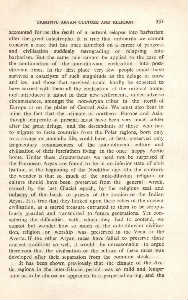Page 576 - Lokmanya Tilak Samagra (khand 2)
P. 576
PRIMlTIVE ARYAN CULTURE AND RELIGION 357
accounted for as the iesult of a natural relapse into barbarism
after the great catastrophe. It is true that ordinarily we cannot
concieve a race that has once launched on a career of progress
and civilisation suddenly retrograding or relapsing into
barbarism. But the same rule cannot be applied to the case of
the continuation of the ante-diluvian civilisation into post-
diluvian times. In the first place very few people could have
survived a cataclysm of such magnitude as the deluge of snow
and ice; and those that survived could hardly be expected to
have carried with them all the civilisation of the original home,
and introduced it intact in their new settlements, under adverse
circumstances, amongst the non-Aryan tribes in the north of
Europe or on the plains of Central Asia. We must also bear in
mind the fact that the climate of northern Europe and Asia,
though temperate at present, must have been very much colder
after the· great deluge, and the descendants of those who had
to migrate to these countries from the Polar regions, born only
to a savage or nomadic life, could have, at best, preserved only
fragmentary reminiscences of the ante-diluvian culture and
civilisation of their forefathers living in the once happy Arctic
home. Under these circumstances we need not be surprised if
the European Aryas are found to be in an inferior state of civi-
lisation at the beginning of the Neolithic age. On the contrary
the wonder is that so much of the ante-diluvian religion or
culture should have been preserved from the general wreck,
caused by the last Glacial epoch, by the religious zeal and
industry of the bards or priests of the Iranian or the Indian
Aryas. It is true that they looked upon these relics of the ancient
civilisation, as a sacred treasure entrusted to them to be scrupu-
lously guarded and transmitted to future generations. Yet con-
sidering the difficulties with which they had to contend, we
cannot but wonder how so much of the ante-diluvian civilisa-
tion, religion or worship was preserved in the Veda or the
Avesta. If the other Aryan races have failed to preserve these
ancient traditions so well, it would be unreasonable to argue
therefrom that the civilisation or the culture of these races was
developed after their separation from the common stock.
It has been shown previously that the climate of the Arc-
tjc regions in the inter-Glacial period was so mild and tempe-
rate as to be aln:ost an approach to a perpetual spring, and tha

